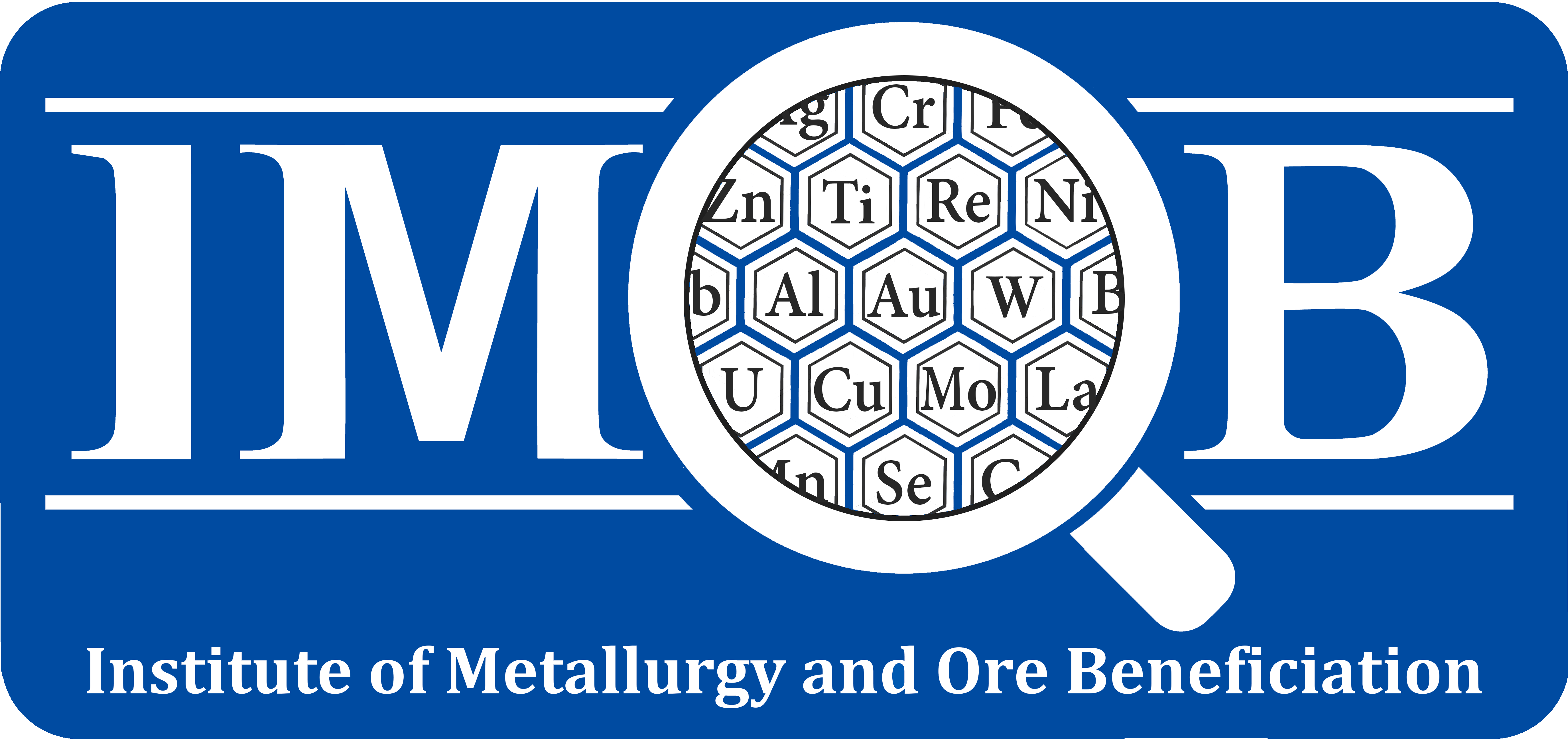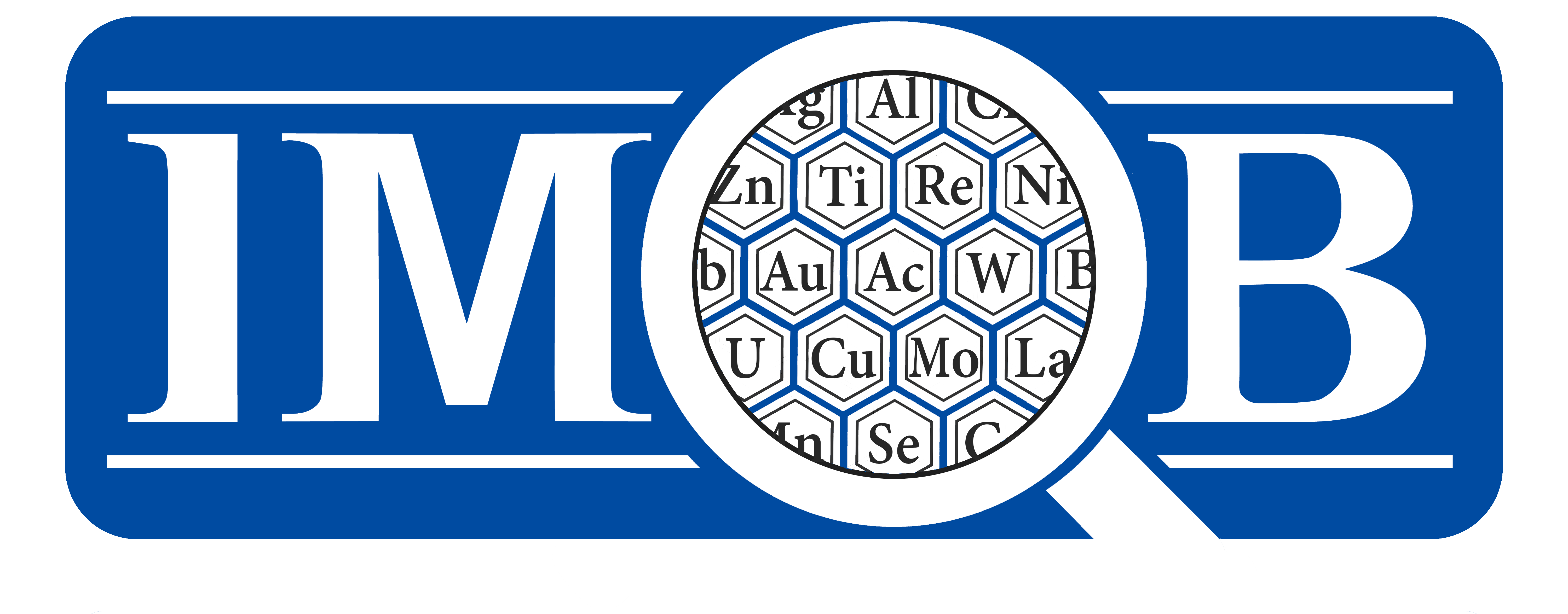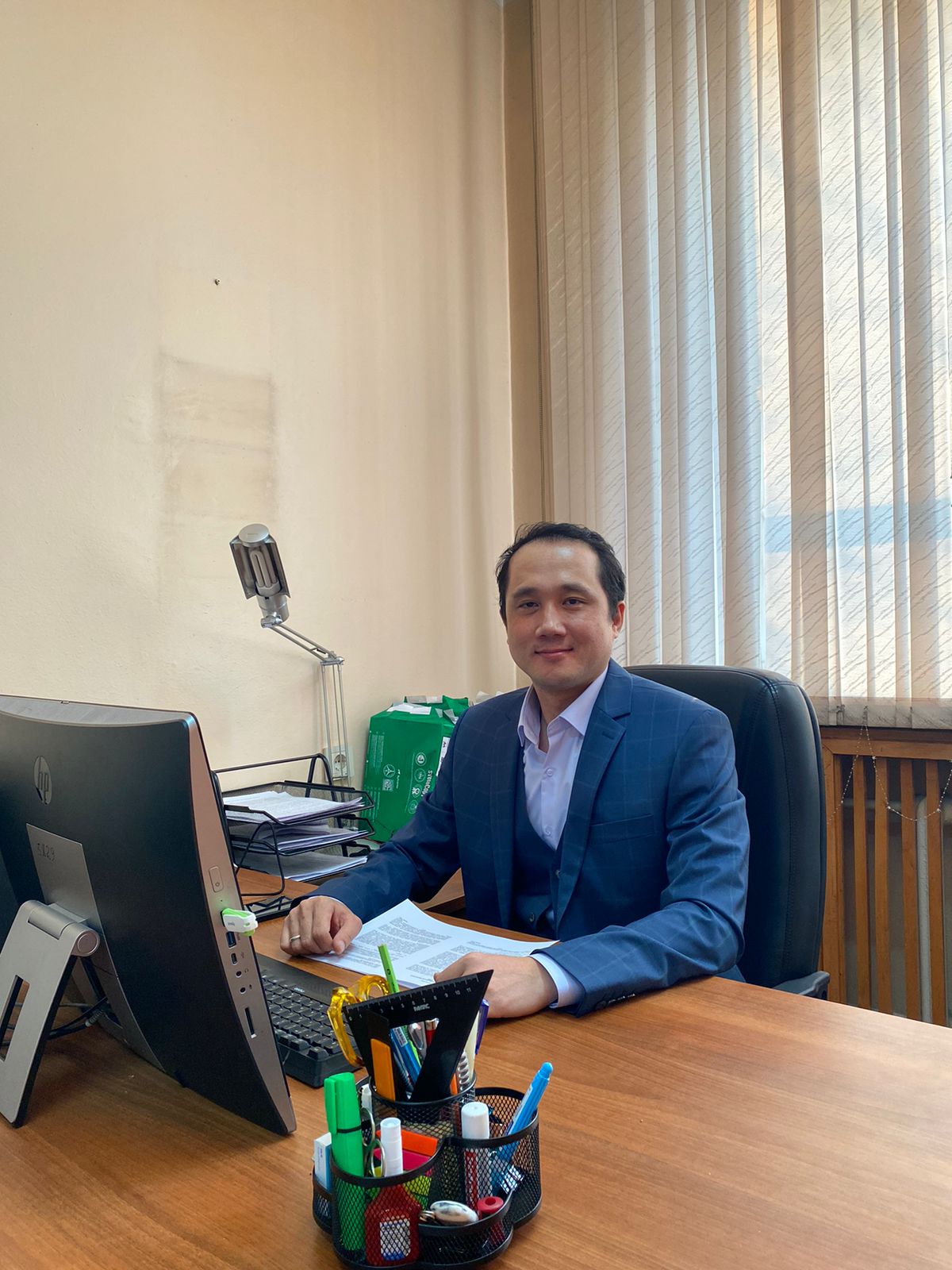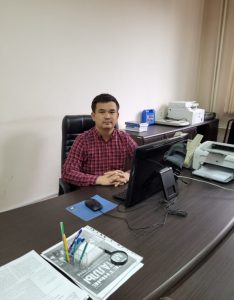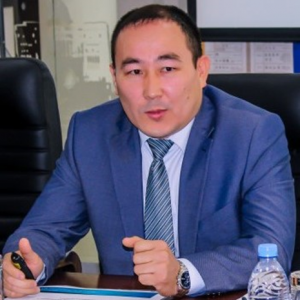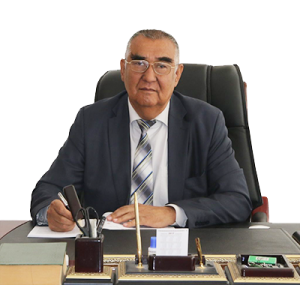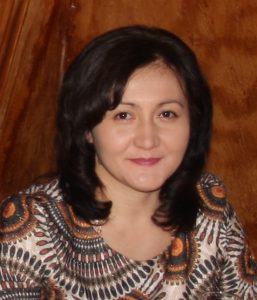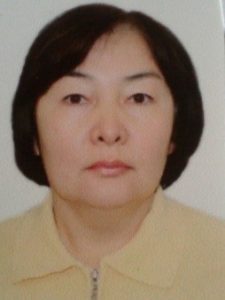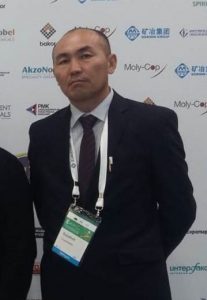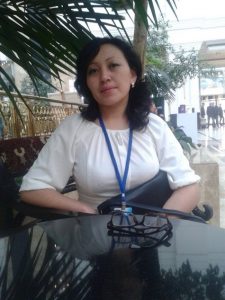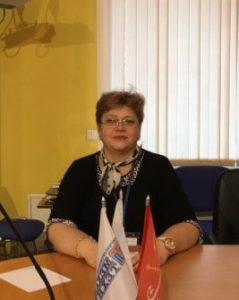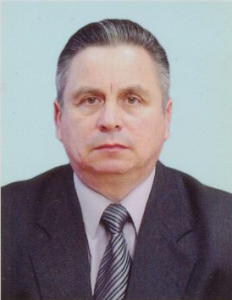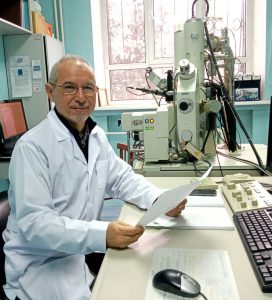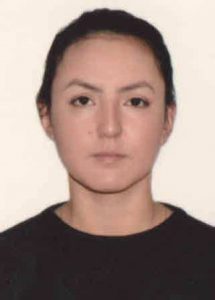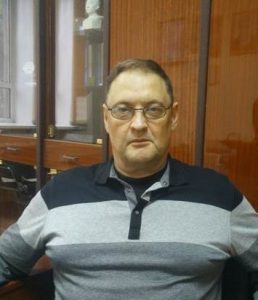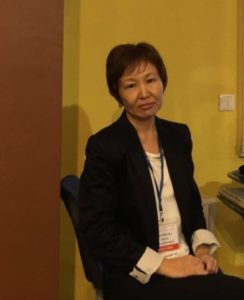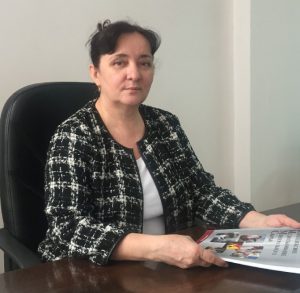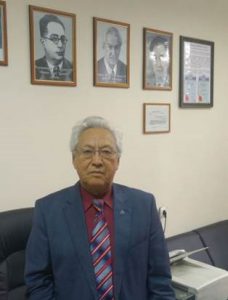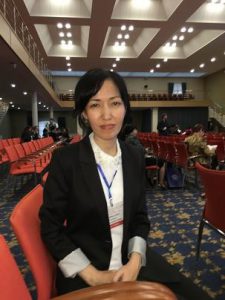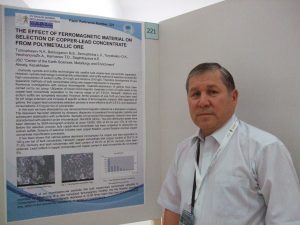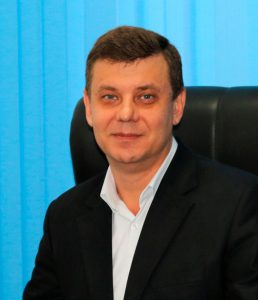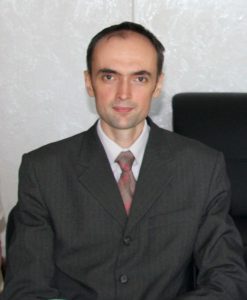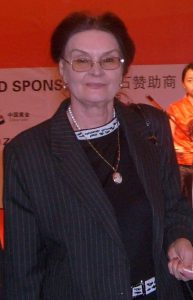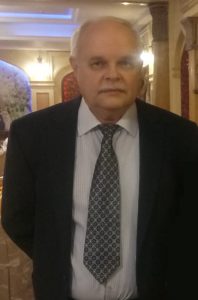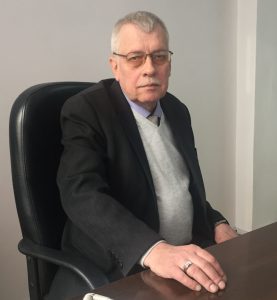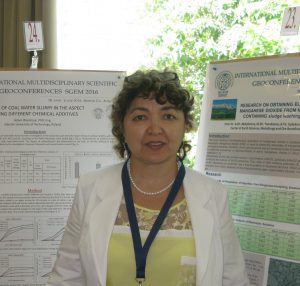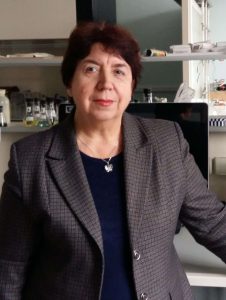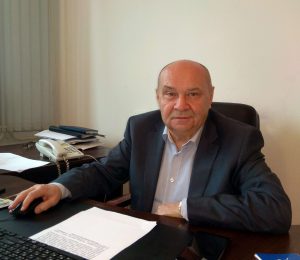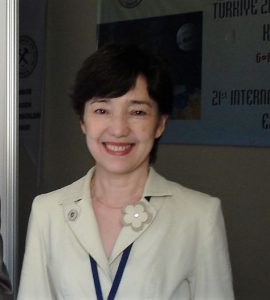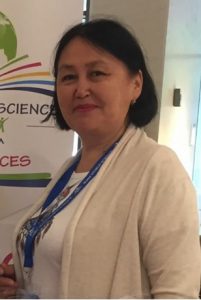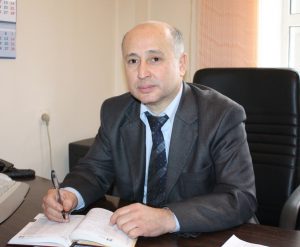АР08856041
«Research, development of technology for processing finely-dispersed raw materials using innovative equipment to accelerate and improve the flotation process performance»
Project Manager: Turysbekov D.K.
Relevance: The low-efficient flotation recovery of micron-sized particles from ores presents one of the important reasons for the substantial losses of recoverable components in processing plants. Concentrators of all countries are involved in solving this problem. The solutions to this problem include the use of combined microflotation to produce water-air microdispersion, which will make it possible to recover additional microdispersed recoverable ore minerals, optimize the flotation process and achieve higher process performance.
Project goal: Development, manufacture of innovative equipment to improve the flotation process of finely-dispersed ores. The recommended technology with new equipment allows extracting microdispersed valuable minerals, which will improve the technological performance of ultradispersed raw materials containing non-ferrous, precious metals: extraction will increase by 3-5%, their content in waste tailings will decrease.
Expected results. The expected research results are as follows:
- the influence exerted on the monomineral flotation of non-ferrous metals of various dispersion by the nature of the produced water-air microdispersion will be studied;
- the process layout will be developed and the equipment to produce laboratory-type water-air microdispersion will be manufactured providing for further refinement of the water-air microdispersion production parameters;
- the equipment will be tested and the initial data will be developed for the process regulations applied to beneficiate finely-disseminated complex raw materials using this equipment. Recommendations are provided for implementation.
Based on the research results, at least 2 (two) articles and (or) reviews in a peer-reviewed scientific journal in the scientific filed of the project, included in 1 (first), 2 (second) or 3 (third) quartiles in the Web of Science database and (or) having a percentile by CiteScore in the Scopus database of at least 50 (fifty); and at least 1 (one) article in a peer-reviewed foreign and (or) domestic journal with a non-zero impact factor (recommended by Committee for Quality Assurance in Education and Science of the Ministry of Education and Science of the Republic of Kazakhstan) will be provided; or at least 1 (one) patent for an invention.
Achieved results:
The influence exerted on the monomineral flotation of non-ferrous metals of various dispersion by the nature of the produced water-air microdispersion studied.
The process layout developed and the equipment producing laboratory-type water-air microdispersion will be manufactured, including further refining of the parameters for water-air microdispersion production, which will accelerate the flotation process and increase the useful component recovery into the concentrate by 3-5%.
Публикации:
1 D. Turysbekov, N. Tussupbayev, L. Semushkina, S. Narbekova, Zh. Kaldybaeva, A. Mambetaliyeva Effect of the water-air emulsion size of the foaming agent solution on the non-ferrous metal minerals flotation ability // METALURGIJA. 2021.- Vol.60.- №3-4, P.395-398. (Web of science, Q3). https://hrcak.srce.hr/256119
2 Turysbekov D.K., Semushkina L.V., Narbekova S.M., Kaldybaeva Zh.A., Mukhamedilova A.A., Musina M.M. Study of the effect of combined microflotation in the beneficiation of poor polymetallic ore // International conference "Problems of complex and environmentally safe processing of natural and technogenic mineral raw materials" (Plaksin readings - 2021), Vladikavkaz, October 04-08, 2021 - pp. 230-234.
Research team members:
ORCID: 0000-0003-0904-1565
https://orcid.org/0000-0003-0904-1565
SCOPUS: 57204797086
https://www.scopus.com/authid/detail.uri?authorId=57204797086
Google Scolar
https://scholar.google.ru/citations?hl=ru&user=65UOXBAAAAAJ
Web of science: P-8963-2017
Publons
https://publons.com/researcher/2044349/dulatbek-k-turysbekov/
ORCID: 0000-0002-6110-0772
https://orcid.org/0000-0002-6110-0772
SCOPUS: 55787968800
https://www.scopus.com/authid/detail.uri?authorId=55787968800
Google Scolar
https://scholar.google.com/citations?hl=ru&user=2UWrxu0AAAAJ
Web of science: AAD-3705-2020
Publons
https://publons.com/researcher/3371509/nessipbay-tussupbayev/
ORCID: 0000-0001-8925-5250
https://orcid.org/0000-0001-8925-5250
SCOPUS: 57204797105
https://www.scopus.com/authid/detail.uri?authorId=57204797105
Google Scolar
https://scholar.google.com/citations?user=--8MrPYAAAAJ&hl=ru
Web of science: P-8970-2017
Publons
https://publons.com/researcher/2044341/semushkina-v-larissa/
ORCID: 0000-0002-7325-754X
https://orcid.org/0000-0002-7325-754X
SCOPUS: 57194232513
https://www.scopus.com/authid/detail.uri?authorId=57194232513
Google Scolar
https://scholar.google.com/citations?user=aobfWcEAAAAJ&hl=ru
Web of science: P-9642-2017
Publons
ORCID: 0000-0001-5956-4730
https://orcid.org/0000-0001-5956-4730
SCOPUS: 56698400500
https://www.scopus.com/authid/detail.uri?authorId=56698400500
Google Scolar:
https://scholar.google.com/citations?hl=ru&user=3yzdlHEAAAAJ
Web of science ID: O-4816-2017
Publons:
ORCID: 0000-0002-7325-754X
https://orcid.org/0000-0002-7325-754X
SCOPUS: 57194232513
https://www.scopus.com/authid/detail.uri?authorId=57194232513
Google Scolar
https://scholar.google.com/citations?user=aobfWcEAAAAJ&hl=ru
Web of science: P-9642-2017
Publons
АР08856229
«Development and testing of advanced technology for the production of durable chromium pellets from finely dispersed chromium concentrate with their melting to ferrochromium»
Project Manager: Bondarenko I.
Relevance: Currently, the production of ferrochromium products of TNK Kazchrome JSC is negatively affected by the factor of deterioration in the quality of raw materials: the total content of chromium oxide decreases, the dispersion of the material increases, the content of impurities harmful to ferroalloys increases, which leads to a decrease in the technical and economic indicators of the processes. Also, the technologies for agglomeration of finely dispersed chrome raw materials used at Donskoy GOK do not provide the passport strength of the obtained pellets and, as a result, a significant yield of substandard products during electric arc melting of raw materials in alternating current furnaces. The proposed technology will provide an increase in the extraction of chromium oxide from fine sludge raw materials, will reduce the consumption of fluxing reagents in the production of pellets and improve the environmental situation in the area where ferroalloy plants are located.
The project goal: Improvement of the technology for the production of chromium materials by effective enrichment of sludge to obtain a finely dispersed chromium concentrate and synthesis of hardened pellets on its basis using a ferrosilicon-calcium binder. The technology will make it possible to obtain pellets with high strength, provide an optimal ratio of components, reduce the pellet firing temperature, increase water resistance and resistance to freezing.
Expected results: The research will:
- determined the physicochemical characteristics of the passport samples of sludge from chrome production and their gravitational concentration;
- a technology has been developed for obtaining rich finely dispersed chromium concentrates from sludge of chrome production; enlarged tests were carried out to obtain complex pellets from chrome slimes;
- large-scale laboratory tests of the melting of fired complex pellets with the production of high-carbon ferrochrome were carried out; the initial data for drawing up the Technological Regulations were issued.
Based on the research results, at least 2 (two) articles and (or) reviews will be published in peer-reviewed scientific journals in the scientific direction of the project, included in 1 (first), 2 (second) or 3 (third) quartiles in the Web of Science database and ( or) have a CiteScore percentile in the Scopus database of at least 50 (fifty); as well as at least 1 (one) article in a peer-reviewed foreign and (or) domestic publication with a non-zero impact factor (recommended by Committee for Quality Assurance in Education and Science of the Ministry of Education and Science of the Republic of Kazakhstan), or at least 1 (one) patent for an invention; recommendations for implementation were given.
Achieved results:
The selection of passport samples of chrome slimes was carried out, their granulometric, chemical, mineralogical composition was studied. The process of gravity concentration of sludge was investigated.
An efficient technology for processing sludge of chrome production has been developed to obtain rich chromium concentrate with a content of more than 50% Cr2O3 and recovery at the level of 75% using a rational gravity concentration scheme, including preliminary separation by feedstock size classes and selective concentration on concentration tables; Large-scale laboratory tests were carried out to obtain pellets based on a composition consisting of chromium concentrate, fine fractions of special coke, ferruginous forms of diatomite and calcium-silico compounds; optimal conditions for obtaining fired pellets based on ferrofluxing binders were determined. The main physical and chemical characteristics of the prototypes have been studied.
Publications:
1 Bondarenko I., Kuldeev Y., Temirova S., Tastanova A., Sadykov N. Obtatingof strong chromium pallets with the use of ferrosilicon-calcium binder // Metalurgija.- 2022.- V.61.- № 2.- Р.359-362. Webofscience (2020) – Q 3. https://hrcak.srce.hr/265922
2 Bondarenko I., Kuldeev Y., Serzhanova N., Sadykov N.,. Tastanova A. The process of benefication of fine chrome sludges on concentration tables // Metalurgija.- 2022.- V.61.- № 2.- Р.381-384. Webofscience (2020) – Q 3. https://hrcak.srce.hr/265928
Research team members:
ORCID ID: 0000-0002-8926-6694
Scopus Author ID: 6505453092
Researcher ID Web of Science: O-4834-2017
https://scholar.google.com/citations?user=nZO7wGAAAAAJ&hl=ru
ORCID: 0000-0001-8216-679X
Scopus Author ID: 55938162800
Web of Science: N-9712-2017
Google Scholar
https://scholar.google.com/citations?user=RadOw4cAAAAJ&hl=ru
Publons
ORCID ID: 0000-0001-9528-8753
ORCID ID: 0000-0003-2088-837X
Scopus Author ID: 57194493565
https://scholar.google.com/citations?hl=ru&user=051sLq1FDzwC
ORCID ID: 0000-0001-9311-9497
Scopus Author ID: 56963807200
Researcher ID: O-9549-2017
https://scholar.google.com/citations?hl=ru&user=KvQ_ys0AAAAJ
АР08855505
«The development of a technology for the integrated processing of fine dust electrofusion of ilmenite concentrates on the extraction of silicon and titanium into commercial products»
Project Manager: Karshyga Z.B.
Relevance: Fine dusts of ore-thermal smelting of ilmenite concentrates are captured in fine bag filters included in the gas collection apparatus of the RKZ furnace. Dust is stored at landfills in the form of waste containing an excess amount of silica up to 20%. The dust volume of each smelting is 10% of the initial charge loaded into the furnace. It contains titanium oxides up to 50% and iron oxides up to 30%. Dusts due to the high silica content cannot be returned to the electrofusion process or fed to chlorinators. Annually, at maximum capacity utilization, UKTMP JSC produces up to 76 thousand tons of chloride waste, including about 600 tons of fine bag filter dust. Under the influence of natural precipitation and wind, the waste is washed away and sprayed, polluting the water and soil basins. The creation of a comprehensive effective technology for the processing of finely dispersed dust of electric smelting will enable us to use these technogenic raw materials and obtain additional marketable products.
The project goal: development of a technology for the integrated processing of dump finely-dispersed dust from electric smelting of ilmenite concentrates with the extraction of marketable products. The goal of the project will be achieved by the selective separation of silicon and titanium by fluoroammonium processing followed by pyrohydrolysis of fluoride sublimates and the production of marketable products.
Expected results of the project:
- separation of silica from dust electric smelting ilmenite concentrates by leaching with sodium alkali will be investigated;
- fluoroammonium methods for separating silica and titanium dioxide will be developed;
- a technological scheme will be developed for the processing of electric smelting dust of ilmenite concentrates to produce white soot and titanium dioxide.
Based on the study results, 2 articles will be published in peer-reviewed scientific journals in the scientific field of the project, included in 1 (first), 2 (second) or 3 (third) quartiles in the Web of Science database and (or) having a CiteScore percentile in the Scopus database of not less than 50 (fifty); 1 article in a domestic publication with a non-zero impact factor (recommended by Committee for Quality Assurance in Education and Science of the Ministry of Education and Science of the Republic of Kazakhstan).
Achieved results: The separation of silica from dust of electrosmelting of ilmenite concentrates by leaching with sodium alkali has been investigated. Fluoroammonium methods for the separation of silica and titanium dioxide have been developed.
Publications:
1 A. Ultarakova, N. Lokhova, A. Yessengaziyev. Silica removal from waste of ilmenite concentrate pyrometallurgical processing / Materials of International Practical Internet Conference “Challenges of Science”. Institute of Metallurgy and Ore Beneficiation, Satbayev University, Almaty, Kazakhstan. Issue IV, 22 November 2021. P. 82-90. e-ISSN 2707-9481. ISBN 978-601-323-252-2. http://kims-imio.kz/en/conference/ https://doi.org/10.31643/2021.12
2 A.А.Ultarakova, Z.B. Karshigina, N.G. Lokhova, A.M. Yessengaziyev, K.K. Kasymzhanov, S.S. Tolegenova. Extraction of Amorphous Silica from Waste Dust of Electrowinning of Ilmenite Concentrate // Metalurgija. 2022, 61(2), p. 377-380. https://hrcak.srce.hr/index.php?show=toc&id_broj=20969
3 Yessengaziyev Azamat, Ultarakova Almagul, Lokhova Nina, Karshigina Zaure, Kasymzhanov Kaysar. Study of the alkaline treatment effect on separation of silica from the electric melting dust of ilmenite concentrates. XXIth International Multidisciplinary Scientific GeoConference Surveying, Geology and Mining, Ecology and Management – SGEM 2021. 14-18 August, Albena. 2021. (In print).
Research team members:
ORCID: 0000-0002-3025-7363
https://orcid.org/0000-0002-3025-7363
SCOPUS: 55831196700
https://www.scopus.com/authid/detail.uri?authorId=55831196700
Google Scholar
https://scholar.google.ru/citations?user=5hS6viAAAAAJ&hl=ru
Web of science: O-5905-2017
Publons
ORCID: 0000-0001-9428-8508
https://orcid.org/0000-0001-9428-8508
SCOPUS: 57192211142
https://www.scopus.com/authid/detail.uri?authorId=57192211142
Google Scholar
https://scholar.google.ru/citations?hl=ru&user=gKWH1_sAAAAJ
Web of science: X-1506-2018
Publons
https://publons.com/researcher/1819499/ultarakova-almagul/publications/
ORCID: 0000-0002-4989-4119
https://orcid.org/my-orcid?orcid=0000-0002-4989-4119
SCOPUS: 57195072267
https://www.scopus.com/authid/detail.uri?origin=resultslist&authorId=57195072267
Google Scholar:
https://scholar.google.ru/citations?user=JzxNDJMAAAAJ&hl=ru
Web of science: AAD-1708-2020
Publons
https://publons.com/researcher/3367167/azamat-yessengaziyev/
ORCID: 0000-0001-8062-8655
https://orcid.org/my-orcid?orcid=0000-0001-8062-8655
SCOPUS: 57216706159
https://www.scopus.com/authid/detail.uri?authorId=57216706159
Google Scholar
https://scholar.google.com/citations?user=4FNHhRkAAAAJ&hl=ru
Web of science: ABD-7287-2021
Publons
ORCID ID: 0000-0001-5476-6560
Google Scolar
https://scholar.google.com/citations?view_op=list_works&hl=ru&user=mZlvw8gAAAAJ
Web of science: AAD-2757-2020
Publons https://publons.com/researcher/3369530/orken-uldakhanov//
АР08856780
«Ecologization of the gold extraction technology using mineral raw materials with the help of alternative microorganisms»
Project Manager: Berkinbayeva A.N.
Relevance: The use of biooxidation technology shows that it is the simplest, most economical, efficient and environmentally friendly way of processing gold-bearing raw materials. The technology is based on the oxidation of sulfide minerals by groups of acidophilic chemolithotrophic microorganisms capable of using sulfides, sulfur and its reduced compounds, as well as ferrous iron ions as a substrate for life. In this regard, the development of methods that increase the efficiency of biooxidation for the extraction of gold from gold-bearing raw materials is an urgent task.
Project goal: Development of environmentally friendly technology to extract gold from Akbakai mineral resources using thionic bacteria Thiobacillus ferrooxidans capable of oxidizing sulfide minerals and acidophilic microalgae Cyanidioschyzon merolae, as well as Galdieria sulphuraria.
Expected results.
- an optimal regime of mineral raw materialsbiochemical break-down using thionic bacteria Thiobacillus ferrooxidans capable of oxidizing sulfide minerals with the release of finely disseminated gold will be proposed. The conditions for gold accumulation by acidophilic microalgae Cyanidioschyzonmerolae and Galdieriasulphuraria will be optimized after processing of mineral raw materials Thiobacillus ferrooxidans.
- optimal technological parameters will be established for the sorption extraction of gold from mineral raw materials leaching solutions.
- based on laboratory testing of gold biochemical extraction from mineral raw materials, initial data will be issued for drawing up technological procedures to extract gold from mineral raw materials of Akbakai deposit. Implementation of the developed technology will potentially allow 5-7 % additional recovery of gold with the biochemical cyanide-free method. During the implementation of the technological process, technogenic environmental pollution is significantly reduced.
Based on the study results, at least 2 (two) articles and (or) reviews will be published in peer-reviewed scientific journals in the scientific field of the project, included in the 1st (first), the 2nd (second) or the 3rd (third) quartiles in the Web of Science database and (or) having a CiteScore percentile in the Scopus database of not less than 50 (fifty).
Achieved results: An optimal mode of biochemical opening of mineral raw materials using thionic bacteria Thiobacillus ferrooxidans, capable of oxidizing sulfide minerals with the release of finely disseminated gold, has been proposed. The conditions for the accumulation of gold by acidophilic microalgae Cyanidioschyzon merolae after the processing of mineral raw materials by Thiobacillus ferrooxidans have been optimized. The optimal technological parameters of sorption extraction of gold from solutions of leaching of mineral raw materials have been determined. For preliminary oxidation of Thiobacillus ferrooxidans with a concentration of ferric iron - 20 g/ dm3, the number of colonies - 6 · 106, biooxidation time - 10 days; concentration of thiosulfate solution - 10 g/ dm3, leaching temperature in thiosulfate solution 18-20 °С; leaching time 24 hours. At the same time, gold recovery is over 90 %.
Publications:
1 Koizhanova A.K., Berkinbayeva A.N., Sedelnikova G.V., B.K. Kenzhaliyev, Magomedov D.R., Efremova (Dyo) Y.M. Research of biochemical gold recovery method usinghigh-arsenicrawmaterials// Metalurgua. - 2021. -№ 60, 3-4. P. 423-426. Scopus: SJR (2018) – 0,42; Q2.
2 Koyzhanova A.K., Sedelnikova G.V., Erdenova M.B., Berkinbayeva A.N., Kamalov E.M. Altyn shygaratyn fabrikanyk kenderinen altyn aludyk biogydrometallurgialik technologiasy // Complex Use of Mineral Resources. 2021. No. 1 (316). S. 24-31.
Research group:
ORCID: 0000-0002-2569-9087
Ainur Berkinbayeva (0000-0002-2569-9087) (orcid.org)
Scopus: 56707368100
Google Scolar:https://scholar.google.com/citations?user=pE5MW4wAAAAJ&hl=ru
Web of science: AAD-2315-2020
Publons: https://publons.com/researcher/3367206/ainur-berkinbayeva
ORCID: 0000-0001-9358-3193
SCOPUS: 55788200200
Google Scolar: https://scholar.google.com/citations?hl=ru&user=bMsDTwgAAAAJ
Web of science: N-4602-2019
Publons:https://publons.com/researcher/2909814/aigul-k-koizhanova
ORCID: 0000-0002-6073-348X
SCOPUS: 57205165757
Google Scolar:
https://scholar.google.com/citations?view_op=list_works&hl=ru&user=jJ5bYR0AAAAJ
Web of science: AAD-3721-2020
Publons:https://publons.com/researcher/3371470/emil-kamalov/
ORCID: 0000-0002-7496-5097
SCOPUS: 55788714400
Google Scolar: https://scholar.google.com/citations?view_op=list_works&hl=ru&user= DECx76gAAAAJ
Web of science: AAD-3716-2020
Publons:https://publons.com/researcher/3371504/maria-erdenova/
ORCID: 0000-0001-5085-7596
АР08856246
«Development of the methods to modify the natural sorbents for uranium extraction using man-made raw materials»
Project Manager: Kenzhaliyev B.K.
Relevance: About 80% of the world's uranium is produced by five countries - Kazakhstan, Russia, Australia, Canada and Nigeria, and production of Kazakhstan is about 40%. Significant amount of the uranium-containing waste is generated during hydrometallurgical treatment of uranium ores. According to experts, more than 200 million tons of uranium-containing liquid waste is accumulated in the Republic as of 2018. In the process of liquid waste solutions recycling, they are purified from uranium and sent by to the process. Sorption uranium extraction is one of the purification methods. Today, sorption purification methods using synthetic and natural sorbents are the most common and effective. Meanwhile, the high cost of synthetic sorbents and low exchange capacity of natural ones are their significant disadvantages. Natural materials are modified to improve their sorption properties. However, there are no real methods of modified sorbents production that would work well in the processes of uranium sorption. In this regard, the issue of developing inexpensive and effective ways to modify natural raw materials in order to produce the sorbents with increased sorption capacity remains relevant for the uranium industry.
The purpose of the project. Development of the useful method for natural sorbents modification in order to extract uranium using man-made raw materials. The method provides for preliminary activation of man-made raw materials by thermo hydrolysis and subsequent finishing treatment of natural sorbents with activated man-made raw materials. The combination of these methods will increase the specific surface area of the modifier particles, and penetration of the particles deep into the matrix will improve the sorption capacity of the sorbent modified.
The research will result in the following:
Material, chemical and granulometric composition of the representative sample of the man-made raw material and its structural features will be determined. The approach of the finishing treatment method implementation will be justified based on the data analysis obtained.
Technological parameters of the man-made raw materials activation by thermo hydrolysis and subsequent modification of natural sorbents using activated man-made raw materials will be developed, as well as physical, chemical and sorption testing of the modified sorbents will be conducted. When optimal conditions are determined, the method of mathematical model construction will be used.
Consolidated laboratory tests of the developed technological process of natural sorbents modification and uranium sorption using sorbents produced will be carried out and initial data will be issued in line to draft the technological regulations and conduct subsequent semi-industrial tests. Preliminary technical and economic assessment will be made.
As a result of research on this project, at least 2 (two) articles and (or) reviews will be published in peer-reviewed scientific publications on the scientific direction of the project, included in 1 (first), 2 (second) or 3 (third) quartiles in the Web of database Science and / or having a CiteScore percentile in the Scopus database of at least 50 (fifty); as well as at least 1 (one) article in a peer-reviewed foreign and (or) domestic publication with a non-zero impact factor (recommended by Committee for Quality Assurance in Education and Science of the Ministry of Education and Science of the Republic of Kazakhstan), or at least 1 (one) patent for an invention; recommendations for implementation were issued.
Results achieved: The material, chemical and granulometric composition of a representative sample of technogenic raw materials, its structural features have been determined. Based on the analysis of the data obtained, the choice of the implementation of the modification method is justified. Technological parameters of activation of technogenic raw materials by thermohydrolysis and finishing of natural sorbents with activated technogenic raw materials have been developed, as well as the physicochemical properties of modified sorbents have been studied.
The indicator of the modification method is the sorption process. It was found that upon activation of phosphorus slag in a chloride medium, the modified natural sorbent actively extracts both uranium (98.5%) and iron (85.3%), and in the carbonate one - only iron (82.5%). This is due to the fact that, as shown by the phase composition, at elevated temperatures in the carbonate medium, phase transformations of both natural minerals and phosphorus slag take place. In a chloride environment, the amorphous phase of the phosphorus slag is retained.
Publications:
- Application for invention No. 2021/0255.1 dated 04.16.2021. Method for extracting uranium from aqueous solutions // Kenzhaliev B.K., Surkova T.Yu., Berkinbaeva A.N., Abdikerim B.E., Esimova D.M., Abikak E.B., Bektayev M.E.
- B.K. Kenzhaliyev, T.Yu. Surkovа, M.N. Azlan, S.B. Yulusov, B.M. Sukurov, D.M. Yessimova. Black shale ore of Big Karatau is a raw material source of rare and rare earth elements // Hydrometallurgy. – Vol. 205. - November 2021, 105733. (Scopus: SJR (2020) – 0,939; Q1, percentile 91). https://doi.org/10.1016/j.hydromet.2021.105733
3. B.E. Abdikerim, B.K. Kenzhaliev, T.Yu. Surkov, A.N. Berkinbaeva, Z.D. Dossymbaeva. Sorption of uranium by organomineral based on shungite // Proceedings of Satpayev readings "Satpayev readings - 2021" Section "Innovative technologies for implementation in the metallurgical industry of the Republic of Kazakhstan". - Almaty, 2021. - pp. 1289-1293.
Research team members:
ORCID: 0000-0003-1474-8354
SCOPUS: 6603486541
Google Scholar
https://scholar.google.com/citations?hl=ru&view_op=list_works&authuser=3&gmla=AJsN-
Web of science: N-9602-2017
Publons
ORCID: 0000-0001-8271-125X
SCOPUS: 55788200200
Google Scholar
https://scholar.google.com/citations?user=tzlLuioAAAAJ&hl=ru&oi=sra
Web of science: AAD-3711-2020
Publons
ORCID: 0000-0002-2569-9087
SCOPUS: 56707368100
Google Scholar
https://scholar.google.com/citations?user=pE5MW4wAAAAJ&hl=ru
Web of science: AAD-2315-2020
Publons
ORCID: 0000-0001-9144-208X
SCOPUS: 56976317400
Google Scholar
https://scholar.google.com/citations?user=Byv5X1IAAAAJ&hl=ru
Web of science: AAD-3718-2020
Publons
https://publons.com/researcher/3371561/zamzagul-dosymbayeva/
ORCID: 0000-0001-5551-2618
SCOPUS: 57144542900
Google Scholar
https://scholar.google.com/citations?user=NHYjiHEAAAAJ&hl=ru
Web of science: P-3620-2017
Publons
ORCID: 0000-0002-1582-6732
SCOPUS: 57191433558
Google Scholar
https://scholar.google.com/citations?user=tHxdCD4AAAAJ&hl=ru
Web of science: AAD-3707-2020
Publons
ORCID: 0000-0003-2538-8585
https://orcid.org/0000-0003-2538-8585
SCOPUS: 57310167800
https://www.scopus.com/authid/detail.uri?authorId=57310167800
АР08855511
« Development of a technology for the autogenous smelting of copper sulfide raw materials while combining the charge loading, oxidizing agent and heat release zones in the melt»
Project Manager: Kvyatkovskiy S.A.
Relevance: In recent years, the main difficulties in the furnace operation have been associated with a lack of iron sulfides in copper concentrates, which leads to a heat deficiency during smelting. Supplying charge and additional fuel (coal) to the melt bath from above and supplying an oxygen-air mixture into the slag melt depth through the tuyeres leads to the charge peroxidation, which results in increased copper losses with slag. The project implementation and the introduction of its results are expected to improve the VF smelting heat balance, reduce the additional fuel consumption for smelting, increase the furnace copper production, reduce losses of copper and precious metals with slags, and reduce the dust entrainment from the furnace.
Project goal: Development of a technology for autogenous smelting of copper sulfide raw materials based on a liquid bath smelting that combines charge supply in one zone. The introduced oxygen-containing blast and fuel will improve the smelting heat balance, prevent melt peroxidation, reduce dust entrainment, the amount of quartz flux used and the resulting slag, as well as the loss of copper and precious metals.
Expected results.
The expected research results are as follows:
- the studied thermal conditions of the existing autogenous smelting in the Vanyukov furnace and tested optimal amount of added quartz flux in laboratory conditions;
- the studied thermal conditions of autogenous smelting in the Vanyukov furnace using additional fuel supplied to the melt liquid bath through tuyeres;
- the studied possible solid charge component supply to a melt liquid bath through tuyeres and its effect on the slag composition, dust entrainment from the furnace and determined optimal slag composition in laboratory industrial conditions of VF operation at BCS.
Based on the research results, 2 articles will be published in peer-reviewed scientific journals on the scientific project direction, included in 1, 2 or 3 quartiles in the Web of Science database and/or having a CiteScore percentile in the Scopus database not less than 50; 1 article in a peer-reviewed foreign and/or domestic publication with a non-zero impact factor (recommended by Committee for Control in the Sphere of Education and Science); recommendations for implementation of the additional fuel, dust and charge supply through tuyeres will be provided.
Achieved results: The studied thermal conditions of the existing autogenous smelting in the Vanyukov furnace and tested optimal amount of added quartz flux in laboratory conditions.
The studied thermal conditions of autogenous smelting in the Vanyukov furnace using additional fuel supplied to the melt liquid bath through tuyeres.
Publications: 1 Dyussebekova M.A., Kenzhaliyev B.K., Kvyatkovskiy S.A., Sit’ko E.A., Nurkhadianto D. The main reasons for increased copper losses with slags from Vanyukov furnace // Metalurgija. – 2021. – Vol. 60, No 3-4. – P. 309-312. Scopus (2020) – 46 %.
2 Соколовская Л.В., Квятковский С.А., Кожахметов С.М., Семенова А.С., Сейсембаев Р.С. Влияние восстановителя на структуру и термические свойства шлаков автогенной плавки медных сульфидных концентратов // Металлург. – 2021. – № 5. – С. 45-51. https://doi.org/51. 10.52351/00260827_2021_05_45. РИНЦ (2019) 0,998.
3 Dyussebekova M.A., Kvyatkovskiy S.A., Kenzhaliyev B.K. & Didik Nurhadiyanto. Dependence of the increased content of copper and magnetite in the slags on the composition of the smelting products // Proceeding book of the International Innovation Arsvot Malaysia IAM2021. – 2021. – Р. 387.
4 Dyussebekova M.A., Kvyatkovskiy S.A., Sokolovskaya L.V., Semenova A.S. Effective methods of depletion of liquid slags of autogenous smelting of copper sulfide concentrates // Матер. конф. «Сатпаевские чтение – 2021». – Алматы: КазНИТУ им. К.И. Сатпаева, 2021. – С. 1325-1329.
5 Патент на изобретение №34934. Печь для непрерывной плавки сульфидных полиметаллических материалов в жидкой ванне / Кожахметов С.М., Квятковский С.А., Семенова А.С., Соколовская Л.В., Ситько Е.А., Сейсембаев Р.С.; опубл. 05.03.2021, Бюл. №9.
6 Sokolovskaya L.V., Kvyatkovskiy S.A., Kozhakhmetov S.M., Semenova A.S., Seisembayev R.S. Effect of reducing agent on structure and thermal properties of autogenous copper sulfide concentrate smelting slags //Metallurgist. – 2021. – Vol. 65, No 5-6. – P. 529-537. https://doi.org/10.1007/s11015-021-01187-w. Scopus (2020) – 38 %.
Research team members:
ORCID: 0000-0002-9686-8642
https://orcid.org/0000-0002-9686-8642
SCOPUS: 57194500597
https://www.scopus.com/authid/detail.uri?authorId=57194500597
Google Scolar
https://scholar.google.be/citations?hl=en&user=lJ6IQl8AAAAJ
Web of science: O-5593-2017
Publons https://publons.com/researcher/2055570/sergey-kvyatkovskiy/
ORCID: 0000-0002-6955-4381
https://orcid.org/0000-0002-6955-4381
SCOPUS: 6602646246
https://www.scopus.com/authid/detail.uri?authorId=6602646246
Google Scolar
https://scholar.google.be/citations?hl=en&user=dRtpiWEAAAAJ
Web of science: O-5586-2017
Publons https://publons.com/researcher/2055577/sultanbek-kozhakhmetov/
ORCID: 0000-0002-8955-2594
https://orcid.org/0000-0002-8955-2594
SCOPUS: 6506296462
https://www.scopus.com/authid/detail.uri?authorId=6506296462
Google Scolar:
https://scholar.google.be/citations?hl=en&user=9FBKONgAAAAJ
Web of science: AAG-8502-2020
Publons: https://publons.com/researcher/3369012/lyudmila-sokolovskaya
ORCID: 0000-0003-4054-8268
https://orcid.org/0000-0003-4054-8268
SCOPUS: 57194503721
https://www.scopus.com/authid/detail.uri?authorId=57194503721
Google Scolar
https://scholar.google.be/citations?hl=en&user=Z7ZVmGoAAAAJ
Web of science: AAG-7666-2020
Publons https://publons.com/researcher/3447750/anastassiya-semenova/
ORCID: 0000-0002-9279-7111
https://orcid.org/0000-0002-9279-7111
SCOPUS: 57219902278
https://www.scopus.com/authid/detail.uri?authorId=57219902278
Google Scolar
https://scholar.google.com/citations?hl=ru&user=faEun_AAAAAJ
Web of science: AAP-7834-2020
Publons
АР08856046
«Research, development and testing of a new technology for processing low-quality gibbsite-kaolinite bauxite with a chemical pre-enrichment»
Project Manager: Abdulvaliyev R.A.
Relevance: The main challenges in involving of low-quality gibbsite-kaolinite bauxite from the Krasnogorsk deposit in processing are related to high concentration of silica and iron carbonates in their composition, which has a harmful effect on bauxite processing technology at the existing plant (Pavlodar Aluminum Plant) and thus makes the production unprofitable. Preliminary chemical activation and thermal transformation of raw materials will increase the efficiency of enrichment of raw materials to obtain bauxite of the required quality.
Aim of the project: Studies of activation mechanisms during chemical enrichment and thermal transformation of bauxite raw materials, development and testing of a new technology for processing low-quality gibbsite-kaolinite bauxite with a chemical pre-enrichment.
Expected Results. The study will result in the following:
- examining the mechanism of chemical activation of gibbsite-kaolinite bauxite of the Krasnogorsk deposit;
- examining the mechanism of thermal transformation of bauxite and developing the technology of chemical enrichment and processing of low-quality bauxite from the Krasnogorsk deposit;
- developing of Material Balance and Technological Specifications for chemical enrichment and processing of low-quality gibbsite-kaolinite bauxite from the Krasnogorsk deposit into alumina and preparing recommendations for the implementation of the technology;
- 2 papers that will be published in peer-reviewed scientific journals focusing on the research area of the project and placed in 1 (first), 2 (second) or 3 (third) quartiles in the Web of Science database and (or) having a CiteScore percentile in the Scopus database not less than 50 (fifty); 1 paper in a local journal with a non-zero impact factor (recommended by Committee for Quality Assurance in Education and Science of the Ministry of Education and Science of the Republic of Kazakhstan).
Achieved results: The material composition of gibbsite-kaolinite bauxites of the Krasnogorsk deposit has been investigated and the mechanism of chemical activation has been studied. The mechanism of thermal transformation of bauxite has been investigated. A technology for chemical enrichment and processing of low-quality gibbsite - kaolinite bauxite from the Krasnogorsk deposit has been developed.
Publications:
Abdulvaliyev R.A., Dyussenova S.B., Manapova A.I., Akcil A., Beisenbiyeva U.Zh. Modification of the phase composition of low-grade gibbsite-kaolinite bauxites // Complex use of mineral raw materials. 2 (2021), -Р.94–102. https://doi.org/10.31643/2021/6445.22
Composition of the project research team:
ORCID: 0000-0001-6747-6984
https://orcid.org/0000-0001-6747-6984
SCOPUS: 56525298100
https://www.scopus.com/authid/detail.uri?authorId=56525298100
Google Scolar
https://scholar.google.com/citations?hl=ru&user=IlR7XRUAAAAJ
Web of science ID: O-6410-2017
Publons: https://publons.com/researcher/2054836/rinat-abdulvaliev/
ORCID: 0000-0001-5956-4730
https://orcid.org/0000-0001-5956-4730
SCOPUS: 56698400500
https://www.scopus.com/authid/detail.uri?authorId=56698400500
Google Scolar
https://scholar.google.com/citations?hl=ru&user=3yzdlHEAAAAJ
Web of science ID: O-4816-2017
Publons: https://publons.com/researcher/2056277/gulnar-abdykirova/
ORCID ID: 0000-0002-9991-0543
https://orcid.org/0000-0002-9991-0543
SCOPUS: 6601997034
https://www.scopus.com/authid/detail.uri?authorId=6601997034
Google Scolar
https://scholar.google.com.tr/citations?user=GYICYPAAAAAJ&hl=tr&oi=ao
Web of science ID: J-1280-2017
ORCID ID: 0000-0002-1990-3678
https://orcid.org/0000-0002-1990-3678
SCOPUS ID: 56698291800
https://www.scopus.com/authid/detail.uri?authorId=56698291800
Google Scolar
https://scholar.google.com/citations?hl=ru&user=Dh-HPuAAAAAJ
Web of science ID: O-2435-2017
Publons:
ORCID ID: 0000-0001-5763-5734
https://orcid.org/0000-0001-5763-5734
SCOPUS ID: 56770094900
https://www.scopus.com/authid/detail.uri?authorId=56770094900
Google Scolar
https://scholar.google.com/citations?hl=ru&user=MApljlcAAAAJ
Web of science ID: O-6417-2017
Publons: https://publons.com/researcher/2054829/nazim-akhmadieva/
ORCID ID: 0000-0002-3258-7948
https://orcid.org/0000-0002-3258-7948
SCOPUS ID: 57193962311
https://www.scopus.com/authid/detail.uri?authorId=57193962311
Google Scolar
https://scholar.google.com/citations?hl=ru&user=QCZYeUUAAAAJ
Web of science ID: O-5873-2017
Publons: https://publons.com/researcher/2055319/alfiyam-manapova/
ORCID ID: 0000-0001-5427-6035
https://orcid.org/0000-0001-5427-6035
SCOPUS ID: 57202813152
https://www.scopus.com/authid/detail.uri?authorId=57202813152
Google Scolar
https://scholar.google.com/citations?hl=ru&user=8K-9p8IAAAAJ
Publons: https://publons.com/researcher/3371765/kasymzhanova-asya/
АР08857049
«Development of wear-resistant, multifunctional, composite titanium carbonitride coating»
Project Manager: Mamaeva A.A
Relevance. In many mechanical systems, materials are subject to friction and wear, which leads to significant energy losses and a decrease in the efficiency of components and mechanisms. Currently, there is a steady trend towards the rejection of the use of liquid lubricants in tribosystems, which is due to both the limitation of their characteristics in a wide range of temperatures and aggressive environments. Therefore, solving the problem of developing coatings with a low coefficient of friction in a wide temperature range is relevant. The TiCN titanium carbonitride coating has satisfactory thermal and wear resistance, a higher oxidation temperature, and a relatively high thermal conductivity in comparison with coatings based on carbides and nitrides of other metals, which are actively developed and used at present.
The way to achieve the project goal is in sequentially performing tasks that are interconnected and include justification for the need to combine the deposition processes of wear-resistant composite coatings, for various sputtering schemes, allowing to take the difficult operating conditions into account in full.
Expected Results.
The effect of magnetron sputtering conditions, content of reaction gases, target and substrate temperature on the deposition rate, structure and formulation of titanium carbonitride films formed on titanium and low alloy steel substrates will be assessed.
Titanium carbonitride coating modes will be developed under conditions of asymmetric power supply to the magnetron sputtering system; the influence of alloying titanium carbinitride coatings on their structure, mechanical properties and corrosion resistance in various environments is determined.
Coatings will be applied to the working surfaces of machine parts and mechanisms, as well as their full-scale tests will be performed; sputtering modes and coating formulation are optimized; technological recommendations for coating based on titanium carbonitride by magnetron sputtering were published.
As a result of studies on this project, at least 2 (two) articles and (or) reviews will be published in peer-reviewed scientific publications on the scientific direction of the project, included in 1 (first), 2 (second) or 3 (third) quartiles in the Web of Science database and/or having a CiteScore percentile in the Scopus database of at least 50 (fifty); as well as at least 1 (one) article in a peer-reviewed foreign and (or) domestic publication with a non-zero impact factor (recommended by Committee for Quality Assurance in Education and Science of the Ministry of Education and Science of the Republic of Kazakhstan), or at least 1 (one) utility model patent; Recommendations for implementation will be issued.
Achieved results: The influence of the conditions of magnetron sputtering, the content of reaction gases, the temperature of the target and substrate on the deposition rate, structure and composition of titanium carbonitride films formed on titanium and low-alloy steel substrates has been estimated.
Modes of coating with titanium carbonitride under conditions of asymmetric supply of the magnetron sputtering system have been developed; the influence of alloying of titanium carbinitride coatings on their structure, mechanical properties and corrosion resistance in various environments is determined.
Publications:
- Kenzhegulov A.K., Mamayeva A.A., Panichkin A.V., Kshibekova B.B., Alibekov Zh.Zh. Deposition of carbonitride titanium coatings by magnetron sputtering and its effect on tribo-mechanical properties //Journal of Friction and Wear. Q3 (Отправлена в журнал, на рассмотрении)
- Mamayeva A.A., Kenzhegulov A.K., Panichkin A.V., Alibekov Zh.Zh., Kshibekova B.B.Effect of magnetron sputtering modes on the formation of titanium carbonitride coatings // Materials Science Poland. Q3 (Переписка с рецензентами)
3. Mamaeva A.A.; Panichkin A.V.; Kenzhegulov A.K.; Kshibekova B.B. (2021). Deposition of a titanium carbonitride coating by magnetron sputtering on a substrate with a potential voltage. Materials of International Practical Internet Conference Challenges of Science. Issue IV, 2021, pp. 103-108. https://doi.org/10.31643/2021.16
Research team employees:
ORCID: 0000-0002-9659-8152
SCOPUS: 57200535299
Google Scholar
https://scholar.google.com/citations?user=0pRdzdgAAAAJ&hl=ru
Web of science: N-8690-2017
Publons https://publons.com/researcher/2060815/axaule-mamaeva/
ORCID: 0000-0002-2403-8949
SCOPUS: 6506771167
Google Scholar
https://scholar.google.com/citations?user=qJvngQoAAAAJ&hl=ru
Web of science: AAD-3003-2020
Publons https://publons.com/researcher/3369172/alexander-panichkin/
ORCID: 0000-0001-7001-2654
SCOPUS: 57210622996
Google Scolar
https://scholar.google.ru/citations?user=umeQ_s4AAAAJ&hl=ru
Web of science: AAD-1637-2020
Publons https://publons.com/researcher/3367121/aidar-kenzhegulov/
ORCID ID: 0000-0002-5944-7865
ORCID: 0000-0002-9366-314X
SCOPUS: 56912389300
Google Scholar
https://scholar.google.com/citations?user=mqOX9awAAAAJ&hl=ru&authuser=1
Publons https://publons.com/researcher/3369852/akerke-imbarova/
ORCID: 0000-0001-9984-4649
SCOPUS: 57195294162
Google Scholar
https://scholar.google.com/citations?user=jWcWPHYAAAAJ&hl=ru
Publons https://publons.com/researcher/2054158/tolebi-dzhienalyev/
ORCID: 0000-0002-9626-3205
SCOPUS: 57208880901
https://scholar.google.com/citations?view_op=list_works&hl=ru&user=-hSOHzsAAAAJ
АР08855494
«Search for an environmentally friendly pyrometallurgical scheme for vacuum processing of metal waste from incinerators»
Project Manager: Trebukhov S.A.
Relevance: The waste disposal technology in thermal waste treatment plants is accompanied by the production of slag containing up to 10% scrap metal that is a secondary raw material for the extraction of non-ferrous metals. A non-ferrous metal concentrate remains after iron slag separation from the metal component; this concentrate contains up to 40% copper, 15% zinc (in the form of brass), up to 5% of lead and tin (in the form of bronze) and precious metals sent to extract copper. Each metal has its own relatively small or large partial pressure of saturated vapor. The project idea is the distillation separation of metals present in a metal concentrate into individual products, the processes combination into an economically feasible process flow with minimization of initial components losses.
Project goal: The project goal is to develop an environmentally friendly technology for the distillation separation of non-ferrous metals present in a metal concentrate obtained by processing waste from waste incineration plants, to produce individual products, i.e. zinc metal, lead and copper concentrates with starting component losses minimization.
Expected results. An environmentally friendly pyrometallurgical process flow for vacuum processing of metal waste from waste incineration plants will be developed as a result of the implementation of the project goals and objectives.
The technology to be developed has an export orientation and may be implemented in the near (Russia, Belarus, Ukraine) and distant (Germany, Switzerland, France) foreign countries. Practical implementation of the project recommendations will make it possible to obtain metallic zinc from waste incineration plants with the global market value of 2000 $/kg.
Achieved results: As a result of the study carried out in 2021, the physicochemical properties, the chemical and phase composition of the concentrate of non-ferrous metals of various sizes, obtained during the processing of slags from incineration plants, were determined. It was found that zinc is in metallic form, and zinc carbide is also found in small amounts. The presence of silver in the concentrate was detected by various methods of analysis, however, its location is not very uniform, which is proved by nitric acid leaching. Gold in the concentrate was not detected by any of the analysis methods used. Based on the research carried out, it was found that zinc in the concentrate is in the metal form and in the form of an alloy with copper - in the composition of brass.
As a result of studying the thermodynamics of melts of the lead-tin and zinc-tin systems, the thermodynamic functions of the formation and evaporation of these alloys were found in the entire range of concentrations, which replenish the base of physicochemical data. And the complete phase diagrams of Pb – Sn and Zn – Sn were constructed, including the fields of coexistence of condensed and vapor phases in the forevacuum (100 and 1 Pa).
Based on the phase diagrams, it was established that the reason for the increased tin content in the lead condensate during the distillation of alloys with a lead content of less than 5 at. % (8.41 wt.%) Are comparable to lead values of the partial pressure of the vapor of tin. In the distillation separation of lead-tin melts by evaporation of lead in a real process under nonequilibrium conditions, the accumulation of tin in the still bottom should not exceed a concentration of ~ 50 wt. %. Exceeding the specified concentration will be accompanied by the production of condensate, which requires a repetition of the process - re-evaporation.
For tin-zinc alloys during distillation separation with the accumulation of tin in the bottoms, technological difficulties are not expected, with the exception of pressure limitations. Distillation of zinc in order to avoid its crystallization from the melt must be carried out at a pressure of more than 30 Pa.
The kinetics of evaporation of binary and multicomponent alloys containing zinc and lead, obtained from a collective initial concentrate with a particle size of + 0.3-0.8 mm, has been studied. Based on the study carried out to determine the rate of evaporation of zinc and lead from a metal concentrate, the possibility of intensive transfer of zinc into the vapor phase was shown, both at 600 ° C and at 900 ° C. Evaporation of lead at a rate sufficient for the technological process is possible only at temperatures above 900 ° C. The values of the rates of evaporation of metals indicate the technological possibility of organizing the distillation process in an industrial environment.
Publications:
1 Требухов С.А., Володин В.Н., Кенжалиев Б.К., Уланова О.В., Ниценко А.В., Требухов А.А., Тулеутай Ф.Х. Способ переработки полиметаллического концентрата от переработки мусора / Заявка №2020/0876.1 от 21.12.2020 г. (in. Rus.)
2 Trebukhov S.A., Volodin V.N., Ulanova O.V., Nitsenko A.V., Burabaeva N.M. Thermodynamics of formation and evaporation of lead-tin alloys // Kompleksnoe Ispol’zovanie Mineral’nogo Syr’a. - 2021. - №1 (316),- P.82-90. http://dx.doi.org/10.31643/2021/6445.10 (in Eng.)
3 Требухов С.А., Володин В.Н., Уланова О.В., Ниценко А.В., Бурабаева Н.М. Термодинамика образования и испарения растворов системы олово-цинк // Журнал неорганической химии. - 2021. - Т.66. - №11. - С.1605-1613. http://dx.doi.org/10.31857/S0044457X21110209 (in. Rus.)
4 Trebukhov S.A., Volodin V.N., Ulanova O.V., Nitcenko A.V., Burabayeva N.M. Thermodynamics of Formation and Evaporation of Solutions of the Tin - Zinc System // Russian Journal of Inorganic Chemistry - 2021. - Vol.66. - No.11. - P.1722-1729. (Scopus Q3, Percentile/Materials Science/ - 52). http://dx.doi.org/10.1134/S0036023621110206 (in Eng.)
5 Требухов С.А., Володин В.Н., Уланова О.В., Бурабаева Н.М., Тулеутай Ф.Х. Переработка полиметаллического концентрата мусороперерабатывающих заводов дистилляцией в вакууме / 28-я Всероссийская научно-техническая конференция с международным участием «Вакуумная техника и технологии – 2021», 22-24 июня 2021 г. Российская Федерация, г. Санкт-Петербург. С.27-31. http://vacuumtt.org/gallery/%D0%92%D0%A2%D0%A2-2021.pdf (in. Rus.)
6 Trebukhov S.A., Volodin V.N., Ulanova O.V., Burabaeva N.M., Tuleutay F.Kh. Processing of Polymetallic Concentrate from Waste Recycling Plants by Distillation in Vacuum / Journal of Physics: Conference Series, 2059 (2021) 012024. (Scopus Q4, Percentile/Materials Science/ - 18). http://dx.doi.org/10.1088/1742-6596/2059/1/012024 (in Eng.)
7 Trebukhov S.A., Volodin V.N., Ulanova O.V., Nitcenko A.V., Burabayeva N.M. Vapour-Liquid Equlibria in the System Tin-Lead in Primary Vacuum // Russian Journal of Non-Ferrous Metals - поступила в редакцию. (Scopus Q3, Percentile/Metals and Alloys/ - 39). (in Eng.)
Research team members:
https://orcid.org/0000-0001-6199-5150.
https://orcid.org/0000-0002-0683-1409
АР08855852
«Development of a technology for obtaining a ferruginous diatomite-based complex coagulant intended to purify industrial and waste waters from hydrogen sulfide»
Project Manager: Kuldeyev Y.I.
Relevance: iron compounds are recognized as promising for the treatment of wastewater containing hydrogen sulfide, as the least toxic, widely used and relatively cheap. We have proposed to use a complex reagent based on ferruginous diatomite, sodium ferrite-aluminates and iron salts for wastewater treatment.
Project goal: development of obtaining a complex iron-containing reagent based on ferrous diatomite, ferrite-aluminates of sodium and iron salts for the purification of industrial and waste water from hydrogen sulfide.
Expected results.
Implementation of the following project objectives provides the following steps:
- research on the development of a method for obtaining a ferruginous diatomite-based complex coagulant intended to purify industrial and wastewaters from hydrogen sulfide: representative sampling of natural diatomite; determination of synthesis conditions for sodium ferrites; physicochemical analysis of the starting materials:
- large-scale laboratory testing of synthesis of a complex iron-containing coagulant at optimal process parameters; production of a pilot lot of coagulant.
- testing of a synthesized coagulant at the water treatment plant with determining the qualitative characteristics of treated water; issuance of source data for the preparation of the Process Regulations
As a result of research on this project, at least 2 (two) articles and (or) reviews in a peer-reviewed scientific journal in the scientific filed of the project, included in 1 (first), 2 (second) or 3 (third) quartiles in the Web of Science database and (or) having a percentile by CiteScore in the Scopus database of at least 50 (fifty); - and at least 1 (one) article in a peer-reviewed foreign and (or) domestic journal with a non-zero impact factor (recommended by Committee for Quality Assurance in Education and Science of the Ministry of Education and Science of the Republic of Kazakhstan) or at least 1 (one) patent for an invention; recommendations for implementation.
Achieved results: research on the development of a method for obtaining a ferruginous diatomite-based complex coagulant intended to purify industrial and wastewaters from hydrogen sulfide completed: representative sampling of natural diatomite; determination of synthesis conditions for sodium ferrites; physicochemical analysis of the starting materials; large-scale laboratory testing of synthesis of a complex iron-containing coagulant at optimal process parameters; production of a pilot lot of coagulant carried out.
Публикации:
- Botantayeva, F.M. Zaihidee. Complex Alumina-Ferrous Coagulant for Effective Wastewater Purification from Hydrogen Sulfide // Advances in Materials Science and Engineering, Vol. 2021, Article ID 5595599, Published 15 May 2021. (Scopus: SJR (2020) – 0,356, процентиль – 62) https://doi.org/10.1155/2021/5595599
- Kolpakova, V., Ospanov, K., Kuldeyev, E., Andraka, D. Clarification of biologically treated wastewater in a clarifier with suspended sludge layer // Water (Switzerland), 2021, 13(18), 2486. DOI 10.3390/w13182486. (Scopus: процентиль – 82 %)
https://www.mdpi.com/2073-4441/13/18/2486/htm
3. Тастанова А.Е., Ботантаева Б.С., Кульдеев Е.И., Бондаренко И.В. Использование соединений железа при очистке сточных вод от сероводорода // Труды Международной научно-практической конференции «Сатпаевские чтения – 2021». Алматы, 12 апреля
2021 г. С. 968-972.
Research team members:
ORCID: 0000-0001-8216-679X
Scopus Author ID: 55938162800
Web of Science: N-9712-2017
Google Scholar
https://scholar.google.com/citations?user=RadOw4cAAAAJ&hl=ru
Publons
ORCID ID: 0000-0003-3039-2546
Scopus Author ID: 55915029400
Researcher ID Web of Science: W-6590-2018
https://scholar.google.com/citations?user=PzgHaJYAAAAJ&hl=ru
ORCID: 0000-0002-1917-7864
Scopus Author ID: 56450780100
Researcher ID: AAA-8499-2020
https://scholar.google.com/citations?hl=ru&user=hbcp5w8AAAAJ
ORCID ID: https://orcid.org/0000-0003-2925-3020
Web of Science: AAD-5520-2020
https://scholar.google.com/citations?user=erW4YHgAAAAJ&hl=en
ORCID ID: 0000-0001-9616-5229
https://scholar.google.com/citations?hl=ru&user=zIOZmSkAAAAJ
ORCID ID: 0000-0003--1953-8938
АР08855565
«Development of a technology to process copper-bearing raw materials using advanced equipment and a combined reagent»
Project Manager: Semushkina L.V.
Relevance: As deposits are depleted and the need to involve poor, finely-disseminated ores in the processing arises, it becomes necessary to improve the reagent ore beneficiation modes, use additives and reagent compositions, and use modernized equipment. A higher recovery of useful components into concentrate may be achieved by flotation beneficiation at various reagent modes. It is possible to use different collector combinations to obtain higher process performance. Given that flotation is the main method for the recovery of non-ferrous metals, the effectiveness of flotation beneficiation will be further determined by developing the reagent mode and improving the methods of using flotation reagents. Urgent tasks in creating innovative beneficiation technologies include search and development of more effective collecting reagents to improve the flotation process, as well as the modernization of equipment used at processing plants.
Project goal: Technology development for processing copper-containing materials using a combined reagent, equipment for its dispersion, which allows increasing the efficiency of flotation process. Proposed technology using dispersed emulsion of combined reagents obtained in flow-type dosing emulsifier will allow intensifying flotation of raw materials containing non-ferrous metals, modernizing equipment in processing plants.
Expected results. The expected research results are as follows:
- the process performance of copper-bearing ore flotation using a combined reagent will be tested;
- a developed effective technology to process copper-bearing ore using a combined reagent and proprietary equipment for its dispersion, which allows to increase the recovery of copper and molybdenum into concentrate by 3-5%;
- completed high-level laboratory tests and developed initial data for the process regulations of copper-bearing raw material beneficiation using a combined reagent emulsion and proprietary equipment for its dispersion. Providing recommendations for implementation.
Based on the research results, at least 2 (two) articles and (or) reviews in a peer-reviewed scientific journal in the scientific filed of the project, included in 1 (first), 2 (second) or 3 (third) quartiles in the Web of Science database and (or) having a percentile by CiteScore in the Scopus database of at least 50 (fifty); and at least 1 (one) article in a peer-reviewed foreign and (or) domestic journal with a non-zero impact factor (recommended by Committee for Quality Assurance in Education and Science of the Ministry of Education and Science of the Republic of Kazakhstan) will be provided; or at least 1 (one) patent for an invention.
Achieved results: The process performance of copper-bearing ore flotation using a combined reagent will be tested.
A developed effective technology to process copper-bearing ore using a combined reagent and proprietary equipment for its dispersion, which allows to increase the recovery of copper and molybdenum into concentrate by 3-5%.
Publications: 1 Semushkina L., Abdykirova G., Turysbekov D., Narbekova S., Kaldybaeva Zh., Mukhamedilova A. About the possibility of copper-bearing ore flotation processing of with the use of a combined flotation reagent // Metalurgija.- 2021.- V.60.- № 3-4.- Р.391-394. Web of science (2020) – Q 3. https://hrcak.srce.hr/256118
2 Semushkina L.V., Abdykirova G.Zh., Turysbekov D.K., Narbekova S.M., Kaldybaeva Zh.A., Mukhamedilova A.M. The use of a combined flotation reagent in the enrichment of copper-containing raw materials // Materials of the International conference "Problems of complex and environmentally safe processing of natural and technogenic mineral raw materials" (Plaksin readings - 2021), 2021. - P.226-229.
3 Semushkina L.V., Abdykirova G.Zh., Turysbekov D.K., Narbekova S.M., Kaldybayeva Zh.A. On the possibility to process copper-molybdenum ore using a combined flotation reagent // Kompleksnoe Ispol’zovanie Mineral’nogo Syr’a = Complex Use of Mineral Resources. - 2021. – V.4. - Issue 319. - Р.57 -64. https://doi.org/10.31643/2021/6445.41.
Research team members:
ORCID: 0000-0001-8925-5250
https://orcid.org/0000-0001-8925-5250
SCOPUS: 57204797105
https://www.scopus.com/authid/detail.uri?authorId=57204797105
Google Scolar
https://scholar.google.com/citations?user=--8MrPYAAAAJ&hl=ru
Web of science: P-8970-2017
Publons
https://publons.com/researcher/2044341/semushkina-v-larissa/
ORCID: 0000-0003-0904-1565
https://orcid.org/0000-0003-0904-1565
SCOPUS: 57204797086
https://www.scopus.com/authid/detail.uri?authorId=57204797086
Google Scolar
https://scholar.google.ru/citations?hl=ru&user=65UOXBAAAAAJ
Web of science: P-8963-2017
Publons
https://publons.com/researcher/2044349/dulatbek-k-turysbekov/
ORCID: 0000-0001-5956-4730
https://orcid.org/0000-0001-5956-4730
SCOPUS: 56698400500
https://www.scopus.com/authid/detail.uri?authorId=56698400500
Google Scolar:
https://scholar.google.com/citations?hl=ru&user=3yzdlHEAAAAJ
Web of science ID: O-4816-2017
Publons:
ORCID: 0000-0002-7325-754X
https://orcid.org/0000-0002-7325-754X
SCOPUS: 57194232513
https://www.scopus.com/authid/detail.uri?authorId=57194232513
Google Scolar
https://scholar.google.com/citations?user=aobfWcEAAAAJ&hl=ru
Web of science: P-9642-2017
Publons
ORCID: 0000-0001-5956-4730
https://orcid.org/0000-0001-5956-4730
SCOPUS: 56698400500
https://www.scopus.com/authid/detail.uri?authorId=56698400500
Google Scolar:
https://scholar.google.com/citations?hl=ru&user=3yzdlHEAAAAJ
Web of science ID: O-4816-2017
Publons:
ORCID: 0000-0002-7325-754X
https://orcid.org/0000-0002-7325-754X
SCOPUS: 57194232513
https://www.scopus.com/authid/detail.uri?authorId=57194232513
Google Scolar
https://scholar.google.com/citations?user=aobfWcEAAAAJ&hl=ru
Web of science: P-9642-2017
Publons
